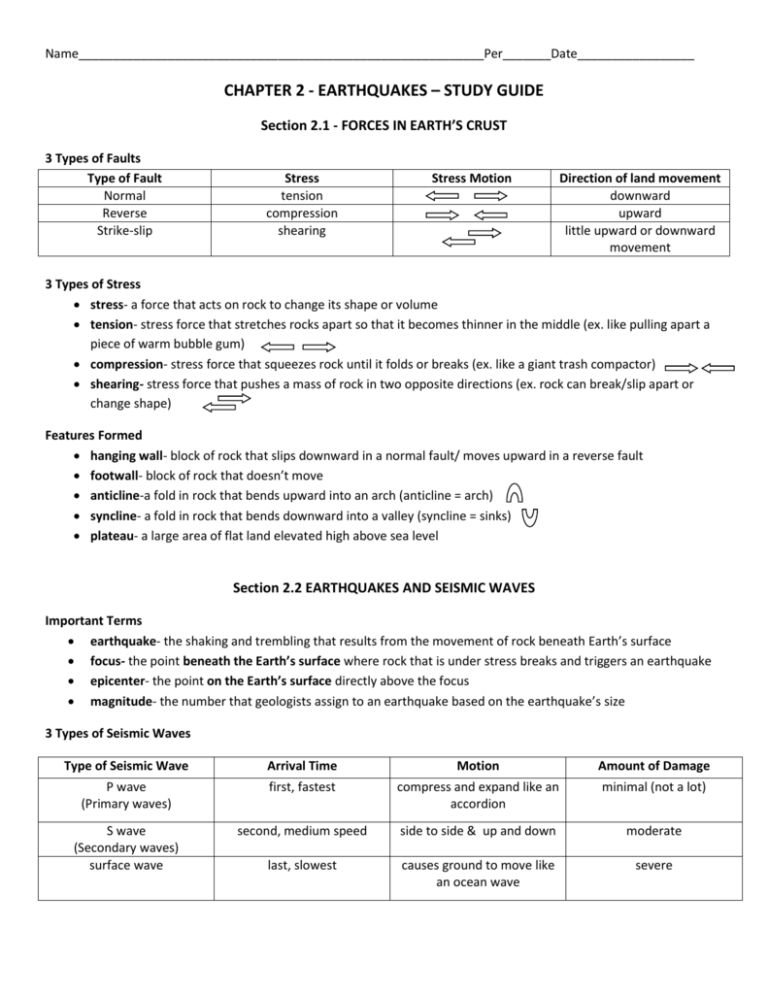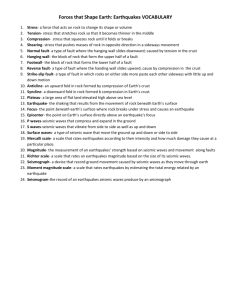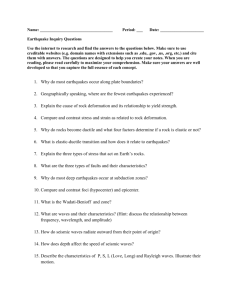Earthquakes Test Study Guide
advertisement

Name___________________________________________________________Per_______Date_________________ CHAPTER 2 - EARTHQUAKES – STUDY GUIDE Section 2.1 - FORCES IN EARTH’S CRUST 3 Types of Faults Type of Fault Normal Reverse Strike-slip Stress tension compression shearing Stress Motion Direction of land movement downward upward little upward or downward movement 3 Types of Stress stress- a force that acts on rock to change its shape or volume tension- stress force that stretches rocks apart so that it becomes thinner in the middle (ex. like pulling apart a piece of warm bubble gum) compression- stress force that squeezes rock until it folds or breaks (ex. like a giant trash compactor) shearing- stress force that pushes a mass of rock in two opposite directions (ex. rock can break/slip apart or change shape) Features Formed hanging wall- block of rock that slips downward in a normal fault/ moves upward in a reverse fault footwall- block of rock that doesn’t move anticline-a fold in rock that bends upward into an arch (anticline = arch) syncline- a fold in rock that bends downward into a valley (syncline = sinks) plateau- a large area of flat land elevated high above sea level Section 2.2 EARTHQUAKES AND SEISMIC WAVES Important Terms earthquake- the shaking and trembling that results from the movement of rock beneath Earth’s surface focus- the point beneath the Earth’s surface where rock that is under stress breaks and triggers an earthquake epicenter- the point on the Earth’s surface directly above the focus magnitude- the number that geologists assign to an earthquake based on the earthquake’s size 3 Types of Seismic Waves Type of Seismic Wave Arrival Time Motion Amount of Damage P wave (Primary waves) first, fastest compress and expand like an accordion minimal (not a lot) S wave (Secondary waves) surface wave second, medium speed side to side & up and down moderate last, slowest causes ground to move like an ocean wave severe Name___________________________________________________________Per_______Date_________________ 3 Types of Scales Mercalli Scale- rates earthquakes according to the level of damage at a given place- 1 to 12 Richter Scale- rating of an earthquake’s magnitude based on the size of the earthquake’s seismic waves- 1 to 10 Moment Magnitude Scale- rating system that estimates the total energy released by an earthquake SECTION 2.3 – MONITORING EARTHQUAKES seismograph- instrument that records and measures seismic waves seismogram- pattern of lines on a seismograph friction- force that opposes the motion of one surface as it moves across another surface SECTION 2.4 - EARTHQUAKE SAFETY liquefaction- occurs when an earthquake’s violent shaking suddenly turns loose, soft soil into liquid mud causing the buildings to sink and pull apart aftershock- an earthquake that occurs after a larger earthquake in the same area; may strike hours, days, or even months later tsunami- a large ocean wave formed when water is displaced by an earthquake base-isolated building – a building designed to reduce the amount of energy that reaches the building during an earthquake; it rests on shock-absorbing rubber pads or springs







